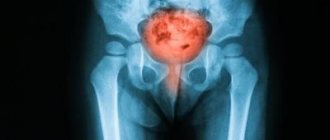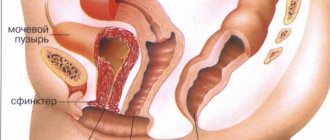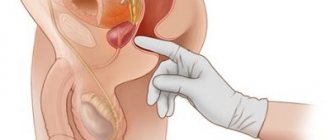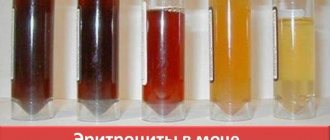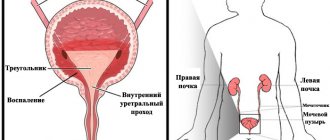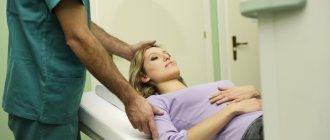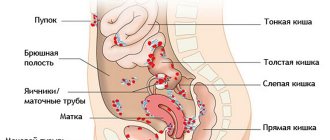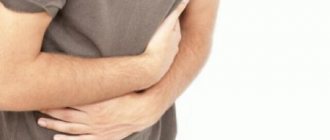Interstitial cystitis is a non-infectious inflammation of the bladder, a rather rare disease. It is rather a symptom complex or painful bladder syndrome. This symptom complex is included in the concept of “painful bladder” or “chronic pelvic pain syndrome”. Most patients are women of reproductive age. Interstitial cystitis occurs in women much more often than in men, and is extremely rarely detected in children and the elderly. Patients may have minimal symptoms for many years and then experience a sudden increase in symptoms. In most patients, the disease stabilizes after some time. Many patients feel that they can continue to live with these symptoms after learning that they do not have cancer. However, without timely and properly treated interstitial cystitis can lead to bladder atrophy with a sharp decrease in capacity and the formation of microcysts.
General important information about the disease
Because interstitial cystitis has a wide range of symptoms and severity, most experts believe it may be multiple diseases.
If you have pain in the bladder area for 6 weeks or more, and you do not have other conditions such as a urinary tract infection or kidney stones, you must have IC (see also - Why does my bladder hurt? What do?). No matter what it is called, the symptoms of interstitial cystitis bring many problems. The disease can negatively affect your social life, physical performance, sleep, and even your professional activities.
Despite this, you can still take control of your life through various treatment procedures through which you can keep the symptoms of the disease under control.
IC is a chronic bladder disease. This condition causes pain and pressure below the navel. Symptoms may come and go or be constant.
Interstitial cystitis causes frequent, urgent, mostly painful urination. In severe cases, you may have to urinate 40 to 60 times a day. It may even keep you awake at night.
Major complications
The disease can lead to a number of clinical consequences, including:
- Decreased quality of life: Frequent urination, pain and discomfort interfere with social, work and daily activities.
- Sexual difficulties (lack of orgasm, decreased desire).
- Emotional problems. Constant pain, discharge, discomfort and interrupted sleep due to trips to the toilet cause chronic fatigue, stress and lead to depression.
- Health problems: decreased bladder volume, urinary tract, hemorrhages, dilation and narrowing of the ureter, reflux, renal failure, ulcerative or trophic lesions of the upper epithelial layer.
Causes
Until now, the causes of interstitial cystitis have not been determined, but scientists suspect that the disease may be associated with the following:
- Problems with the tissues of the bladder allow components of urine to irritate it.
- Inflammation causes your body to produce chemicals that ultimately cause the symptoms of interstitial cystitis.
- Something in your urine is damaging your bladder.
- Problems of the nervous system provoke the sensation of pain in the bladder, when there should be no pain.
- Your immune system attacks your bladder (autoimmune reaction).
- Another disease causes inflammation that also spreads to the bladder.
You can learn more about the causes of cystitis in women on this page - Cystitis: causes in women, types, risk factors.
Risk factors
Women are more likely to develop interstitial cystitis compared to men
The following factors are associated with an increased risk of developing painful bladder syndrome:
- Floor. Interstitial cystitis is diagnosed more often in women than in men. Sometimes men have symptoms associated with interstitial cystitis, but later find out that they are caused by inflammation of the prostate gland (prostatitis).
- Skin and hair color. White-skinned and red-haired people have an increased risk of developing interstitial cystitis.
- Age. Most people with interstitial cystitis are diagnosed in their thirties or later.
- Having chronic pain. Interstitial cystitis may be associated with other chronic pain disorders, such as irritable bowel syndrome (IBS) or fibromyalgia.
Symptoms
The signs and symptoms of interstitial cystitis vary from person to person. They may change every day or week, or remain the same for months or years. Symptoms can either start suddenly or go away suddenly, even without treatment.
Flank pain is one of the symptoms of IC.
Common symptoms of interstitial cystitis:
- Pressure and pain in the bladder, increasing when the bladder is full.
- Pain in the lower abdomen, lower back, pelvis, or urethra (urethra).
- In women, pain in the vulva, vagina, or area behind the vagina.
- In men, pain in the scrotum, testicles, penis, or area behind the scrotum.
- Frequent urge to urinate (more than 7 - 8 times a day).
- An urgent urge to urinate (may occur even immediately after visiting the toilet).
- Women experience pain during sex.
- In men, pain during orgasm or after sex.
Bladder pain in people with IC can range from a dull ache to an unbearable stabbing pain. During urination, a person may experience both a slight tingling sensation and a severe burning sensation.
All people suffering from interstitial cystitis experience an inflamed bladder. 5% to 10% of people with IC develop ulcers in the bladder.
Here's what can make the symptoms of this disease worse:
- Certain foods or drinks
- Stress or physical tension
- Women's periods
Prevention of IC
As with any cystitis, prevention of IC consists of proper care of the genitourinary system. It is necessary to treat inflammatory diseases in a timely manner, control possible allergies, be less nervous and follow a moderate diet. A good practice would be adequate physical activity and an annual preventative examination with a doctor.
Interstitial cystitis is a nebulous disease with no clearly defined causes or treatments. People who encounter it should prepare for a long marathon with doctors. But do not despair - the current level of medicine allows you to reduce or stop symptoms, achieve remission, recover and return life to an adequate course.
Diagnostics
A urine test is the first thing done for IC.
There is no diagnostic method that can definitely indicate interstitial cystitis. If you come to the doctor complaining of bladder pain, frequent urge to urinate, and an urgent need to urinate, the next step is to rule out any medical conditions that may be causing these symptoms.
In both men and women, urinary tract infections (UTIs), bladder cancer, sexually transmitted diseases and kidney stones must be ruled out.
In women, endometriosis is another possible cause that should also be excluded. In men, IC may be mistaken for inflammation of the prostate or chronic pelvic pain syndrome.
The following diagnostic procedures can exclude other diseases:
- General urine analysis and bacterial culture of urine . You will be asked to urinate into a container. It will be sent to a laboratory to test the urine for infection leading to cystitis.
- Residual urine volume . An ultrasound scan shows the amount of urine remaining in the bladder after urination.
- Cystoscopy . A thin tube with a camera is used to view the inside of the bladder and urethra. This procedure is usually only done if there is blood in the urine or if treatment does not help.
- Biopsy of the bladder and urethra . A small tissue sample is taken for analysis. This procedure is usually performed during cystoscopy.
- Bladder distension . Your bladder fills with fluid or gas, which distends it. This procedure is performed under general anesthesia. It is also sometimes used as a treatment for interstitial cystitis. This is done during cystoscopy.
- Bacterial culture of prostate secretion (in men) . Your doctor will massage your prostate to encourage it to release some secretions. This secretion sample is tested for the presence of various bacteria. This type of analysis is done quite rarely.
Treatment
There are five lines of treatment for interstitial cystitis. Let's consider them sequentially.
First line - treatment at home
Muscle stretches are recommended for IC.
About half of cases of interstitial cystitis go away on their own. Most people who need treatment will be able to get their lives back on track.
Treatment of interstitial cystitis mainly comes down to controlling the symptoms of the disease. Of course, you will have to use trial and error to find the right combination of treatment methods that are effective in your case. The search process usually takes from several weeks to several months.
The first stage of treatment is aimed at identifying and eliminating what is worsening the symptoms of IC, as well as making lifestyle changes that will help reduce the painful manifestations of the disease.
- Try to train your bladder . For example, if you feel the need to urinate every 30 minutes, try extending this time to 45 minutes.
- Less stress . Negative experiences and nervous tension can cause interstitial cystitis. Take 5 minutes a day to reduce your stress levels. The proven methods described here will help you - How to get rid of stress - 10 best ways.
- Wear loose clothing . Tight clothing can put pressure on the bladder.
- Do low-intensity physical activity . For example, walking or stretching.
- Change your diet . Below is a list of possible foods and drinks that can cause and worsen IC symptoms.
- Smoking . If you smoke, quit this bad habit.
Many people find that drinking certain foods or drinks irritates their bladder. There is no need to immediately remove all these foods from your diet. Pay attention to which foods make your symptoms worse, and vice versa, which ones can improve your condition. Perhaps the best idea for you would be to keep a special journal in which you record how you feel and what you eat and drink. With daily records, you can track the impact of certain foods on your symptoms. Not all of these foods will negatively affect every person.
Foods that often worsen the condition of IC:
- Citrus fruits such as oranges, lemons, etc.
- Tomatoes
- Chocolate
- Drinks containing caffeine such as coffee, tea and cola
- Carbonated drinks
- Alcohol
- Spicy food
- Artificial sweeteners
Talk to your doctor about an elimination diet, which might help you figure out what's negatively affecting your bladder.
Second line treatment for interstitial cystitis
Physiotherapy to relax the pelvic muscles
If lifestyle changes do not control your condition well enough, try the following treatments:
- Physiotherapy . This is done to relax the pelvic muscles.
- Amitriptyline . This drug controls bladder spasms. It is the most widely used oral drug for IC.
- Pentosan (Elmiron) . It's not yet clear how this drug works, but it may help repair tissue in the lining of the bladder. Treatment may take several months, after which symptoms improve.
- Hydroxyzine . This medication is an antihistamine and may be helpful if you suffer from a persistent urge to urinate at night.
Third line treatment for interstitial cystitis
If the second line of treatment for IC does not work, your doctor will likely turn to a third line of treatment. Here you will need to perform a cytoscopy using a special endoscope used to examine the inner surface of the bladder. This procedure is often performed in the operating room under general anesthesia.
If you haven't yet seen a urologist (a doctor who specializes in treating bladder problems), your doctor may refer you to one.
- Bladder distension . Slowly stretching the bladder wall with fluid can help relieve the symptoms of interstitial cystitis. If it helps, the effects usually last about 6 months. Repeated treatment may help.
- Steroids . If you have bladder ulcers (Hanner's ulcers), your doctor may cauterize them, or treat them with steroids.
- Dimethyl sulfoxide (DMSO) . If other drugs do not provide relief, this drug is inserted into the bladder through a catheter. This remedy relieves inflammation and blocks pain. Doctors do not recommend doing this often because it requires multiple visits to the doctor and because it may temporarily worsen IC symptoms.
Fourth line of treatment for interstitial cystitis
Neurostimulation for Interstitial Cystitis
If the lifestyle changes, medications, and treatments mentioned above are not doing enough and your symptoms are negatively impacting your quality of life, your urologist may try the following treatments:
- Neurostimulation . The doctor uses a device that applies a small electrical current to your nerves to change how they work.
- Botulinum toxin type A injections (Botox) . This temporarily paralyzes the bladder muscles and relieves pain.
Fifth line of treatment for interstitial cystitis
When all the above treatments fail, there is something else you could try:
- Cyclosporine . This drug suppresses the immune system.
- Surgical intervention . In very rare cases where nothing works, this may be the last known option. This is a complex operation whose purpose is to drain urine away from the bladder.
Even if all of the above treatments for interstitial cystitis do not work for you, pain management with painkillers, acupuncture, or other methods may help keep symptoms under control.
